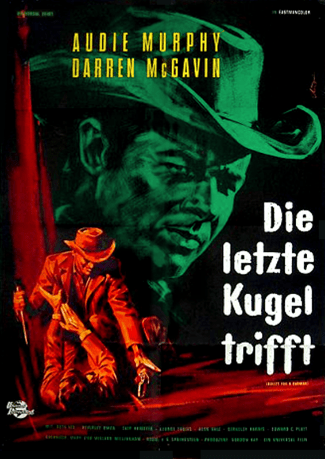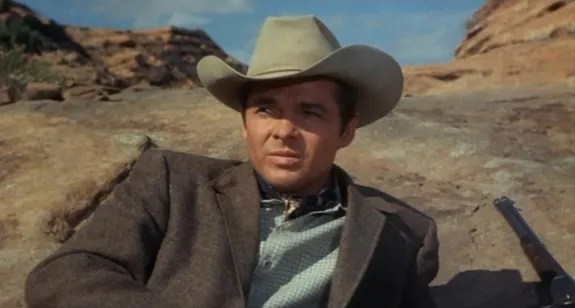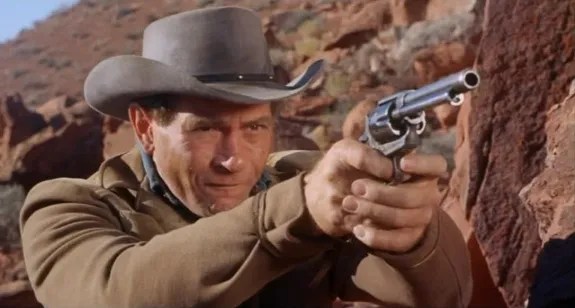Predictability tends to be the scourge of good storytelling. You know the feeling, when you can tell right from the beginning exactly where a writer is heading, how the story is going to develop and what the characters will do. That’s not to say there’s no enjoyment to be derived from such situations, but it’s awfully hard to get enthused about the questionable allure of the familiar. So, having no doubt whetted everyone’s appetite with an opening hook like that, I’d like to say how much a pleasure it is when the promise of the humdrum is swept away and the potentially trite is actually revealed as an impostor. This is kind of how I feel about Bullet for a Badman (1964), where the opening suggests we’re going to be served up one of those vaguely dispiriting mid-60s efforts, the type of western that highlights the weariness which had crept into the genre during those years. Well if you shouldn’t set too much store by the cover of a book, then I guess this movie goes some way towards bearing out the parallel truism about not judging a film too harshly on the basis of its opening.
Bullet for a Badman starts off with two men setting out on paths that are soon to converge on the town of Griffin. Sam Ward (Darren McGavin) is an outlaw, his status as a genuine badman established by the cold-blooded killing of an informer, and he’s finalizing his plans to rob the bank in town and then pay a most unwelcome visit on someone he once knew. That someone is Logan Keliher (Audie Murphy), who’s preparing to ride into Griffin with his boy to negotiate financing for his land. The first quarter of an hour or thereabouts play out much as you might expect given the build up I’ve sketched in above. Anyone who has seen even a handful of westerns would most likely be nodding with a sense of uninspired expectation at about this point – the stereotypical characters and circumstances are lined up just the way we anticipate, but then they change tack. The relationships aren’t quite as we’d been led to believe, there’s a complex back story governing the actions and reactions of these people, and what we thought we knew is only the half of it. The revelation of the nature of the connection between Keliher and Ward comes fast and immediately adds a significant amount of meat to the bones of what had looked for all the world like a pretty clapped out tale. Furthermore, once the narrative carries us out of Griffin into the wilderness in the company of the fugitive Ward and the pursuing posse we run into some more previously unsuspected twists. The preconceptions we were actively encouraged to foster in the opening section are whipped away and replaced by a challenge – if the badman we were shown in the early stages isn’t quite excused, then it is at least suggested that we look at those on his trail and ask ourselves whether they are really much better.
I’ve mentioned how the plot, and consequently the characterization, shifts gear after the preliminaries are taken care of and the film moves away from the town of Griffin. Well as that takes place the visual style of the movie naturally alters too. At the beginning there is that flat look that you see in some TV productions of the era, lighting that’s a little too solid and uniform, an over-reliance on sets and mock-ups – the result is not just an artificial appearance, which certainly has its merits, but a cheap one. Cameraman Joseph F Biroc had an impressive list of credits in both television and cinema but it’s not till we get out among the Utah locations that the best of his talents become apparent. Generally, location shooting has the effect of opening things up, of making a movie feel bigger. That’s the case with Bullet for a Badman, where the film is given the opportunity to breathe away from the backlot. Director R G Springsteen did a lot of TV work, so much that anyone with an interest in the small screen of the period must surely have seen some of his work. Prior to that he made a lot of budget westerns and, to an extent, one could say he was returning to his roots with this, the elusive Showdown also with Murphy, and a handful of A C Lyles pictures. I found his direction here satisfactory overall, but he does let the pace lag a bit in the second act.
I spoke a bit about Audie Murphy’s growing assurance as an actor last year when I wrote a piece on Apache Rifles, a film which was made around the same time as this. Without wishing to go over the same ground repeatedly, let me just reiterate that the abilities which were always there were put to ever more effective use by Murphy as he grew older and grew into the movies; the more complex the role, the more of himself he seemed to put into it. The script by Mary and Willard Willingham, adapted from a Marvin H Albert novel, had protagonist and antagonist as former comrades in the Texas Rangers now cast as rivals by their love of the same woman. There’s plenty of scope for juicy drama in a situation like that, but it needs someone strong to take the part of the antagonist. Here it’s Darren McGavin, another guy I associate primarily with television. I guess many people will think of him as Carl Kolchak from the 70s series and the two reportedly superior TV movies (which I still haven’t seen!), although I’ve also gotten used to him as the 50s version of Mike Hammer. But is he the real villain of the piece? I’ll let each person decide for themselves on that one – suffice to say Skip Homeier, George Tobias, and even Alan Hale Jr have the chance to explore the less savory side of their characters. As for the women, Beverley Owen has a fairly straightforward and typical part as the object of McGavin and Murphy’s affections, while Ruta Lee got more screen time along with a showier if no more original role.
The UK DVD of Bullet for a Badman contains a good print of the movie transferred attractively but economically to disc. There are no supplements at all but the film looks very good, particularly the aforementioned location shooting. The movie itself is one which starts in a frankly pedestrian manner and threatens to become mired in the doldrums. However, it does shake off those routine constraints to become something much more fulfilling. While it does tap into some of the redemptive themes and the richer qualities to be found in the better 50s productions, I don’t want to oversell it either. That opening section is decidedly trite and there are occasional lapses in that direction as it goes along, but I feel that it builds sufficient momentum to keep it fresh for the most part.



Viewed it a long time ago and was not very impressed by it. In fact I have entirely forgotten about it until you just reviewed it. Will have to look for it once again. If I am not mistaken, found it to be just so so and not one of the best from Audie Murphy and anything from R.G. Springsteen is at best watchable. Best regards.
LikeLike
There was a lot of fairly humdrum material being produced in that mid-60s period, tired stuff that never seemed entirely sure where it was going or what points it wanted to make, but this felt like a cut above some more routine pictures. I’ll not argue that it represents the best of Murphy but it does offer him a good, complex role and the plot goes in some (for me anyway) interesting directions.
LikeLike
This sounds like a really nice surprise – always up for that!
LikeLike
Yes, that’s how I’d look at it. It isn’t one of the great lost westerns of the decade or anything so grand, just refreshingly better than you might expect.
LikeLike
Always a great feeling. Surprisingly good film is better than any surprise ending
LikeLike
Well indeed – the latter is essentially a gimmick and not much more. The former feels like a reward for perseverance and dedication at times. 🙂
LikeLike
Just as soon as I find an Italian edition …
LikeLike
Hmm, seems to be one of the few Audie Murphy titles yet to make an appearance on disc in Italy. On the plus side, there is stuff coming out there all the time – I see Gunsmoke is due in early April, for example – so I’d say it will show up sooner or later.
LikeLike
Thanks for that. You probably ought to do an Audie Murphy top 10 for the uninitiated!
LikeLike
You know, that is a really good idea – one that’s certainly worth further consideration at the very least.
LikeLiked by 1 person
I was very pleased to read this review as this is one of the early viewings that made me an Audie Murphy fan. There is nothing like the pleasure of being unexpectedly surprised.
LikeLike
Glad you enjoyed it, and you’re quite right about those pleasant or positive movie surprises – it doesn’t happen all the time but that’s part of what makes it nice I suppose.
LikeLike
I’ve always liked this one, mainly for the chance to see Darren McGavin in an Audie Murphy picture. It’s got a great cast overall.
The location shooting does a lot for the film, and it seemed to inspire Springsteen a bit. Murphy was pretty much the last man standing at this point, and I appreciate the fact that these guys were still out there making these things.
One last thing: you REALLY need to see the Night Stalker TV movies. What I wound’t give for a Blu-Ray of those things.
LikeLike
The location work opens the story up in every sense and it’s a big part of what makes it work well for me.
And yeah, I keep hearing very good things about the Night Stalker TVMs and they remain in the top half of my to-do list when I get the chance.
LikeLike
My introduction to Darren McGavin c. 1961 was his starring role in the TV “western” series, “RIVERBOAT”. Not really a natural for the western genre maybe but he and Audie worked well together in this film, I thought. Good to read your analysis, Colin.
For the record, Jonathan over at Hollywood Scrapheap released this film 2-3 months ago – so there’s another version available to buy.
LikeLike
I’ve never seen Riverboat, Jerry, although I’ve eyed it a few times on DVD – looks like it might be enjoyable.
LikeLike
Haven’t seen this since I was a youngster. Of course I’m a fan of both leads work and yes you should see those Kolchak movies. 🙂 One of the rare Audie films I don’t have so I’ll go looking for that UK edition I guess. Thanks for recalling this one.
LikeLike
The Kolchak movies seem to be almost universally recommended and I will have to catch up with them sooner rather than later.
I find it a bit odd that the studio never released a DVD of this movie in the US or Canada, especially since they licensed out a very good print in the UK, and some time ago too. Strange.
LikeLike
What a fine review, Colin – right up to your usual standard. I like the way you’re so balanced, weighing up strengths and weaknesses and neither over- or under-selling what you’ve seen. As usual, I’m left wanting to dig out another film I haven’t seen.
LikeLike
Very kind of you, Steve – we aim to please. 🙂
We all come away from movies with different feelings and reactions and this title was one of those where the overall impression on me was positive. I can’t promise everyone will get the same buzz I did but I’d still recommend giving it a go if/when possible.
LikeLike
Murphy did get better as he went along. But they probably never gave him much of a chance early in his career. By the time he got to Unforgiven (Directed by John Huston) he was good.
LikeLike
I feel he had ability from early on and even if some of the roles he was assigned initially weren’t of the type which allowed much wriggle room, there is evidence of potential. As the years went by there was an improvement in the roles themselves, which aided further. Of course, there was also something of a dip in quality in some (although by no means all) parts when we move into the next decade.
LikeLike
Nice write-up as usual, Colin. I will be adding this one to the list for future viewing. The director, R G Springsteen, who as you pointed out did a pile of tv work, also made several quite watchable low budget REPUBLIC crime and noir films such as, HARBOR OF MISSING MEN, OUT OF THE STORM, STREET BANDITS and SECRET SERVICE INVESTIGATOR. The last film is an early lead by L. Bridges. STREET BANDITS is one of my personal favorite low budget productions. Review at IMBD.
LikeLike
Not seen any of those Springsteen titles but I thought his work on this was generally fine and the location shooting helped a lot.
LikeLike